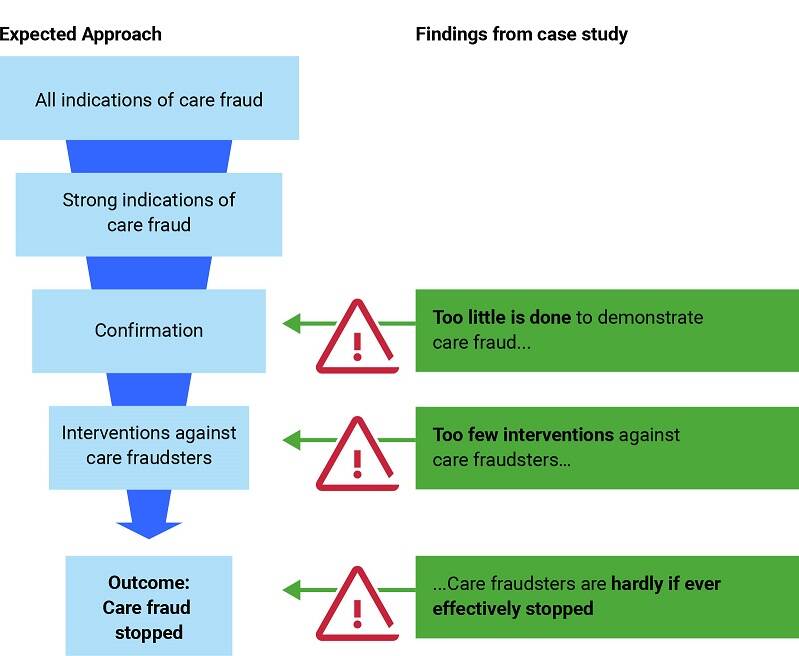A worrying lack of decisiveness
Audit of the policy to combat care fraud
Measures to combat fraud involving public care funds rarely if ever work in practice. Supervisors and law enforcement agencies frequently consult care insurers and municipalities about suspicious cases but the chance of catching the fraudsters is low.
Even when suspicions are very strong, few if any results are booked. The Netherlands Court of Audit says there is a worrying lack of decisiveness.
The Court of Audit investigated the measures taken in 14 cases with strong indications of fraud in 3 care sectors that fraud investigators consider to be susceptible to the misuse of funds: district nursing, youth care and sheltered and supported housing. It also investigated the performance of various partnerships and alliances that have been set up to combat care fraud. Reconstructions of cases of suspected fraud revealed that where fraud is demonstrated it usually does not lead to the fraudster being stopped or even significantly hindered.
Policy has little if any effect in practice

What are our recommendations?
We recommend that the Minister of Health, Welfare and Sport and the Minister for Long-term Care ensure that tasks and agreements are performed correctly regarding the work and results of the organisations that fall directly under their ministerial responsibility (the Health and Youth Care Inspectorate and the Dutch Health Authority) or that are contracted as service providers on their behalf (the Labour Inspectorate).
We also recommend that firm agreements be made with the Minister of Finance and the Minister of Justice and Security on the available capacity and results required from the Tax and Customs Administration, the Fiscal Information and Investigation Service and the Public Prosecution Service. Specific agreements should also be made on which organisations take the lead to investigate cases where there are strong indications of fraud so that they can take action faster and jointly where necessary to uncover fraud and intervene. More can be done within the existing legal frameworks.
Why did we audit care fraud?
Good and affordable care is a very valuable public asset. It is often at the top of lists of what people value the most. Public outrage was therefore not unexpected when the media began publishing ever more urgent reports as from 2018 of care providers bending or breaking the rules. The actions of ‘care cowboys’ who made huge profits was a particular cause of uproar among the public and also in the House of Representatives. Had the profits been earned legally? And shouldn’t public money be returned to the care sector? There were also fears that vulnerable members of the public would be the victims of fraudulent care providers. The new government has named combating care fraud as one of its priorities. But what has the policy on care fraud achieved so far?
What audit methods did we use?
The audit was principally an investigation of the effectiveness of the policy in practice. We opted for a bottom-up audit approach in which we could formulate practical lesson for the system. For our audit we began with cases that had strong indications of care fraud. We investigated what had been done with the indications as a result of the actions of the organisations that combat care fraud. The method we used is known as process tracing: we collected all available information from all the organisations combatting care fraud in order to reconstruct a series of events in which there was a plausible link between cause and effect.
To express a more general opinion on the effectiveness of the policy to combat care fraud, we selected critical cases for the process tracing. These were cases that potentially involved more than just the events named in the cases themselves. As we could not be sure in advance that all important indications of care fraud had been shared with the Care Fraud Information Hub (IKZ), we also selected cases provided by care insurers and municipalities. In addition, we held dozens of interviews with the organisations concerned and studied relevant documents.
What data did we use in this audit?
We used data from the cases in this audit.
Current status
At our request, the Minister for Long-term Care responded by letter to our findings. The letter (in Dutch) has been posted on this website. The report was sent to the House of Representatives and the Senate on 14 April 2022. The report has been published on the Court of Audit’s website.